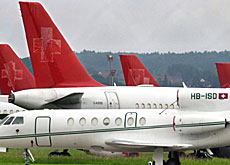Swissair saga shows risks of uncontrolled take-off

It is now three years since the grounding of Swissair sent shock waves through the entire country.
But a recent study shows that the former national airline is not the only Swiss company paying the price of unrealistic expansion strategies.
The study by consultants Bain & Company concludes that only one Swiss company in ten has succeeded in combining steady growth with consistent profitability over the past decade.
The list of strategic failures includes some of the biggest names in Swiss industry – and some businesses that have scored very high on individual measures, such as short-term profitability.
For instance, telecoms giant Swisscom may have more money in the bank than it can currently spend, but its attempts at foreign expansion have been less than a success story.
In addition to the recent setback involving Telekom Austria, the company has notched up a whole string of botched expansion attempts in eastern Europe and Asia – not to mention the loss of some SFr3 billion ($2.4 billion) on its failed Debitel venture in Germany.
And even some of the country’s most conservative blue-chip companies have had their fingers badly burned by misconceived strategic adventures.
Roche, Credit Suisse, Zurich Financial Services, Winterthur and Swiss Life are among those that lost billions of francs in the period 2001-2002.
Financial firefighters
While companies choose to expand in different ways, they tend to adopt similar measures when expansion goes wrong: restructuring, divestments, cost-cutting and staff layoffs.
Some consultants say they have had enough of being called in only at the last moment, to play what amounts to the role of “firefighter”.
“It is frustrating for us to have to intervene only to define and implement restructuring and lay-off plans,” said Christoph Winterer, a partner at Bain & Company.
“Instead of always having to resort to these instruments once the situation has got out of control, companies should simply plan their growth strategies more effectively.”
But what is the key to simultaneous growth and profitability? To find an answer to that question, the consultants analysed the figures of 100 of Switzerland’s biggest companies over a ten-year period.
The study set three criteria for success: an annual revenue increase of at least 5.5 per cent, a comparable annual profit increase, and annual shareholder profit.
Core competencies
“What is interesting is that… the successful companies come from a wide range of different sectors,” said Winterer.
The top performers range from Serono (life sciences), via Logitech (IT), Lindt & Sprüngli (chocolate) and Rieter (textile and automobile industry supplies), to power companies BKW and Atel.
But pretty well all them have one thing in common – they have focused on a clearly defined core business or competence and avoided the temptation to diversify into superficially attractive areas where they lack a clear competitive advantage.
“Lindt & Sprüngli, for instance, has always remained faithful to the chocolate business,” Winterer commented. “They didn’t even try expanding into the closely-related biscuits sector.”
Even when they expanded abroad, they did so with the greatest possible care, only acquiring companies with which they had a long history of prior cooperation.
Indeed, the study shows that 75 per cent of bankruptcies involving medium and large companies can be traced back, at least in part, to unsuccessful attempts at expansion outside Switzerland.
While Swiss companies are obviously constrained by the small size of the domestic market, the cold fact is that the “Made in Switzerland” brand only bestows a genuine marketing edge in a few select areas.
Furthermore, international competition – particularly from Asia – has increased fiercely over the past few decades.
Which way next?
Ludwig Allgöver of the St Gallen management centre points out that the trend to expand outside core areas dates back at least to the 1980s.
At the time, it was justified partly on the grounds that diversification “spread the business risk”.
However, management in many companies was simply not able to deal with the often-unexpected challenges posed by new markets.
In the early 1990s, companies refocused largely on core markets, before once again tending towards diversification in the boom years of the late 1990s.
Since the financial crash of 2001 and 2002, companies appear to be less obsessed by short-term profit margins and the shareholder value concept.
“At the moment, the trend is to develop growth strategies that aim at long-term results,” Allgöver concluded.
“However, no one knows how long this trend will last.”
swissinfo, Armando Mombelli
The study by consultants Bain & Company examined 100 large companies over a ten-year period.
It evaluated success according to three criteria: growth in revenue, growth in profit and shareholder profit (after deducting the cost of capital).
Top performers included power companies Atel and BKW, biotech giant Serono, and chocolate maker Lindt & Sprüngli.
Three years ago, Switzerland’s national airline was grounded after an ambitious growth strategy ran up against reality.
But a recent study shows that Swissair was not the only company to take a strategic wrong turning in the 1990s.
It concludes that the secret of success is a crystal-clear definition of what constitutes a company’s core business.

In compliance with the JTI standards
More: SWI swissinfo.ch certified by the Journalism Trust Initiative











You can find an overview of ongoing debates with our journalists here . Please join us!
If you want to start a conversation about a topic raised in this article or want to report factual errors, email us at english@swissinfo.ch.